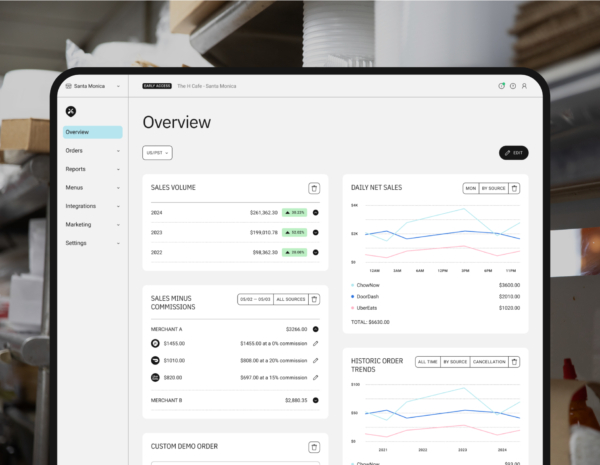AI For Restaurants: Simple Ways To Use AI In Your Business Starting Today

AI has been making headlines for years, usually tied to self-driving cars, facial recognition programs, and flashy video and image generation tools, but rarely the restaurant industry.
When you do hear the words “AI” (artificial intelligence) and “restaurant industry” in the same sentence, it’s often about automated robots flipping burgers and dunking fries—but that’s for fast food chain corporations with deep pockets and huge budgets for expansion.
So where does that leave you—the independent restaurant owner who’s open to new technology, yet unsure how or where to start using AI in your restaurant?
Here’s the part that doesn’t make the headlines: you don’t need robots or multi-million dollar systems to benefit from AI in restaurants.
Everyday tasks, like writing a quick Instagram caption, spotting low-performing menu items, or summarizing guest reviews, can be made faster and easier with tools that are not only affordable, but practical and ready to use today.
In this article, you will learn:
- How to use simple AI tools to save time on daily tasks
- Ways AI for restaurants can improve marketing, menus, and guest feedback
- Tips to test AI technologies without a big budget or major risks
Why AI Matters For Restaurants Right Now
AI isn’t some distant, futuristic idea anymore—it’s already here, and independent restaurant owners are already using it to save time, make smarter decisions, and improve operational efficiency.
The tools that once felt reserved for big chains or tech-savvy startups are now accessible to anyone in the restaurant industry, no matter your budget or background.
You don’t need to invest in robots or install complex systems to benefit from AI in restaurants.
Simple, everyday tasks, like writing a menu description, planning a promo, or responding to a review, can now be done faster and more efficiently with AI tools. These small improvements might not seem like much on their own, but together, they free up time, reduce stress, and help your team work smarter.
The best part is that many of these AI-powered tools are either free or low-cost. You can start using them today—no IT team required.
Whether you’re testing out generative AI like ChatGPT to help write your next special or using a spreadsheet add-on to analyze what dishes are dragging down your margins, the barrier to entry has never been lower.
Let’s take a closer look at how leveraging AI can help your restaurant starting today.
Save Time On Everyday Restaurant Marketing

If you’ve ever found yourself staring at a blinking cursor trying to write a last-minute post—or skipping marketing altogether because you just don’t have time—AI for restaurants can help.
Generate social media ideas in minutes
Every restaurant owner knows the struggle of keeping up with social media posts. Instead of staring at a blank screen, you can use AI tools to spin up caption ideas, photo prompts, or short video scripts in seconds. It takes the pressure off and keeps your feeds consistent.
Repurpose content into fresh formats
Your newsletter, employee spotlight, or restaurant website bio doesn’t have to live in just one place. With artificial intelligence, you can feed it into the system and repurpose it into Instagram carousels, a short promo email, or even TikTok scripts.
Automate promotion brainstorming
The holiday season always arrives faster than we think it will, and planning your seasonal marketing promotions is time-consuming and difficult at the best of times.
With content creation AI and other AI-driven tools, you can brainstorm promotion ideas instantly. The same digital marketing tools can even adjust your message to better reflect customer preferences, helping you stay relevant without the late-night stress sessions.

Make Smarter Menu Decisions
Your menu is at the heart of your business, and even small tweaks can make a big difference to sales and customer satisfaction. By using AI in restaurants, you can make smarter decisions based on facts instead of gut feelings.
Spot your top-sellers and low performers
Instead of manually crunching numbers, you can use AI tools, like Google Sheets add-ons to process sales data quickly.
By analyzing your reports, you’ll know which dishes are your consistent winners and which ones drag down profits. Looking at historical data this way makes it easier to decide what stays, what goes, and what deserves more promotion.

Find upsell opportunities
Guests often want guidance on what pairs well together. Using AI solutions powered by predictive analytics and natural language processing, you can uncover the add-ons, sides, and modifiers guests are most likely to choose.
By analyzing historical data, these tools highlight natural pairings (the simplest examples are fries with burgers or wine with pasta) that boost check size without overcomplicating your menu.
Test menu wording and descriptions
Words matter. Small tweaks in your menu descriptions can improve both customer engagement and sales. With generative AI, you can test multiple versions of a description on your physical menu and direct online ordering menu to see which resonates more with guests.
Think of it as low-stakes A/B testing for your menu copy—fast, inexpensive, and based on actual customer demand.
Improve The Guest Experience

Every interaction with a guest, whether online or in person, shapes your restaurant’s reputation. With the right AI technologies, you can make those touchpoints faster, friendlier, and more personalized without losing the human touch.
Spot trends in reviews quickly
Instead of sifting through dozens of comments, you can use AI-powered tools to scan and summarize feedback. This makes it easy to spot service issues, track food quality, and notice recurring compliments that can be used in your marketing efforts.
Draft quick responses to feedback
Timely replies to customers’ reviews show you care. AI-powered virtual assistants can help draft responses that you can edit and send in seconds, cutting down on the time it takes to handle customer inquiries while still maintaining your own tone.
Personalized follow-up messages
How guests remember and grow to love your restaurant is built on the little things. You can use AI-powered solutions to personalize:
- Thank you notes/follow-up emails
- Reminders about your loyalty program
- Upcoming event invitations
When done right, this improves customer satisfaction, strengthens customer loyalty, and creates a better overall restaurant experience.
Streamline Operations And Reduce Waste
Keeping the back-of-house organized is just as important as serving great food in the dining room. With restaurant AI, operators can simplify day-to-day tasks, cut costs, and create smoother restaurant operations without adding more work for their team.
Automate and optimize staff scheduling
Labor costs are often the largest expense for restaurant operators. By tapping into AI-powered systems, you can generate smarter staff schedules that balance shifts with real customer demands.
Instead of relying on guesswork, these tools help manage restaurant employees in a way that saves money while still delivering a great dining experience.
Improve inventory management
Ordering too much drives up costs, while ordering too little risks not enhancing customer experiences. AI software can support better inventory management by drawing insights from historical data and identifying ordering patterns within your supply chain.
That means fewer shortages, better portion planning, and less food waste over time.
Turn reports into plain-language insights
Numbers in daily reports don’t always tell a clear story. With modern restaurant technology, you can use AI tools that translate data into straightforward insights for staff.
Whether it’s identifying slow nights, tracking waste management, or surfacing profitable menu items, these tools improve operational efficiency and free you to focus on growth.
Start Small And See Results

AI doesn’t have to feel overwhelming. The simplest way to bring it into your restaurant is to pick just one area (marketing, menu planning, reviews, or operations) and test it out.
Starting small makes it easier to see what actually helps without adding stress to your day.
You don’t even need to invest in expensive software right away. There are free and low-cost options available that can make a huge difference in your business.
Check out these AI tools to get started:
- ChatGPT to brainstorm promotion ideas or draft responses to reviews
- Google Sheets add-ons to analyze sales patterns and plan your purchasing more accurately
- Grammarly to polish your writing and eliminate grammatical errors and spelling mistakes
- Canva’s AI features to create graphics for social media posts or in-house signage
The key is to keep the experiments manageable and track the results.
Did an AI-generated caption save you time?
Did a scheduling suggestion reduce payroll headaches?
Did a forecast help you order more accurately?
Those small wins add up, and they’ll give you the confidence to expand your use of AI step by step.

Explore Free and Affordable AI Tools To See What Works For Your Business
Don’t feel like you need a big budget or be a tech wizard to get started using AI for restaurants. These companies want you to adopt these tools so they’re made affordable and very approachable for people of any technical skill level—you just have to get started.
AI for Restaurants Frequently Asked Questions
What is the easiest way to start using AI in my restaurant?
Pick one simple task you already do every week, like writing a social post, summarizing sales reports, or drafting a response to a review, and try an AI tool for that. Starting small helps you see value right away without getting overwhelmed by trying to do too many new things at once.
Do I need expensive software to benefit from AI?
No. Many free and affordable AI tools are available today. Platforms like ChatGPT, Google’s Gemini, and Grammarly can make everyday tasks easier without requiring a big investment.
Can AI replace my staff, or is it just a support tool?
AI can’t replace the hospitality and human touch that make restaurants special. Think of it as an assistant—it can save time on repetitive tasks so your staff can focus more on guests.
How do I know if AI is helping my business?
Track simple outcomes. Did you save time on scheduling? Did an AI-generated caption drive more engagement online? Did AI-analyzed inventory sheets reduce waste? Look for small but measurable results that add up over time.
What are the risks of using AI in a restaurant?
The biggest risks are relying too heavily on generic outputs or using tools without checking accuracy. Always review what AI produces, protect sensitive customer data, and treat it as a support tool—not a replacement for your team’s judgment.





